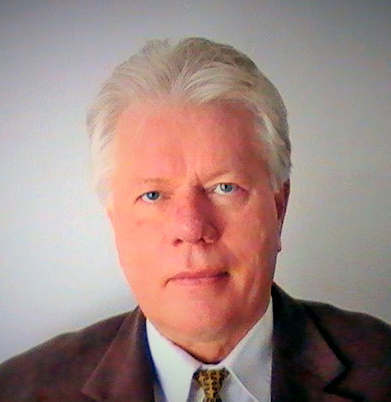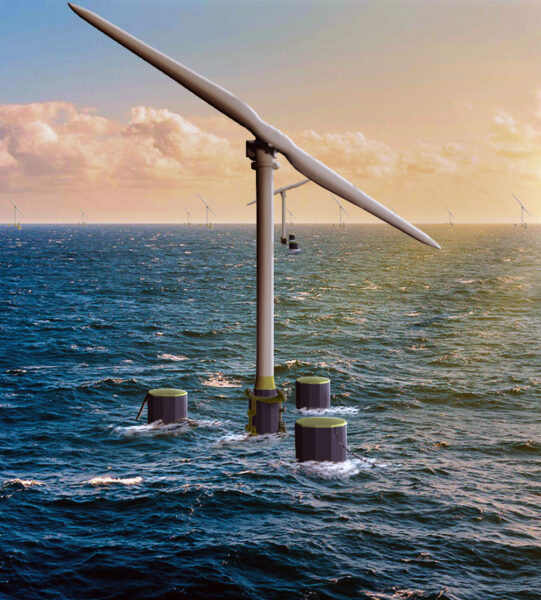Members' interviews
Interview with Martin Jakubowski, Chairman and President of Seawind Ocean Technology

1 October 2020
We sat down with Martin Jakubowski to discuss developments in the wind industry, the growth of wind energy technologies, and the impact of COVID-19.

Can you tell our readers a little about your organisation?
Seawind is a technology development company and Original Equipment Manufacturer (OEM), producing the next generation of floating, fully integrated wind turbines, co-founded in 2014 by myself and Silvestro Caruso. Since then we’ve developed our innovative technologies and expanded into a fantastic team of industry experts, such as our energetic CEO Vincent Dewulf and many others.
We are active in the UK, Ireland, Italy, Greece and France where we have started marketing our two prototypes, Seawind 6 (6,2 MW) and Seawind 12 (12.2MW). Both are two-bladed wind turbines with a teetering hinge on a semi-submersible concrete floating foundation. Therefore, we provide a fully integrated floating wind turbine system installed at sea. We have 28 patents and 12 are pending and DNV GL, in December 2019, awarded the Seawind technology Type D certification.The history of our technology dates back to the late ’70s, when NASA, Boeing, Hamilton Standard (later UTC) and other US groups developed a two-bladed wind turbine technology based on the helicopter rotor principle; and not on the propeller rotor principle as done in Europe at that time. Already, the famous German aircraft pioneer, Anton Flettner, stated that a helicopter rotor is better suited for wind turbines than the propeller rotor, as it reduces drastically the fatigue on rotor and hub, which is fundamental in the offshore environment. Additionally, our solution removes the need for blade pitching, with power control only required by active yawing into or out of the wind. This concept was proven by the 1.5 MW Gamma 60 prototype, which operated for 6 years and fundamentally proved that yaw control works.
The adoption of these design principles makes the wind turbine much simpler, with significantly fewer parts and therefore less weight. Our Seawind 12 has a low head weight of 640 tonnes compared to the head weight of 850 tonnes, which is lower than the competitors on the market. This in essence dramatically increases the power generated per tonne of the unit, making it a highly efficient turbine. Reducing complexity of the turbine and the head weight on top a floating system is very important to ensure the stability of the structure and to optimise the technology.
How has Seawind Technology responded to the COVID-crisis?
We are a start-up, lean in our beliefs and practice. We are a truly European company – our team operates from their locations in 9 different European countries: the Netherlands, Belgium, Germany, France, Italy, the UK, Ireland, Spain and Turkey. We do so via digital means of communication.
The COVID-crisis has actually helped us a lot and has made this form of communication generally accepted around the globe. We have benefitted very much from the change in mental patterns regarding communication. This also drastically reduces our expenses for travelling, saves a lot of time and avoids a lot of CO2 emissions!
Due to the above, I can say that Seawind has come out stronger from the COVID-crisis. In fact, Seawind is currently launching its funding campaign towards a number of selected investors. We are very pleased about the initial reactions received so far. We are seeing a shift in investment interest towards the green recovery post COVID and investment pioneers wanting to realise the success of the rapidly growing floating offshore wind sector.
What are the most exciting developments you have seen in the wind industry in recent years?
When I was showing the concept of a floating wind turbine in 2006/7 at the – at that time – EWEA conferences and exhibitions in Brussels and Milan, many people, especially from Germany, were expressing ‘deep uncertainty’, to put it mildly, about a floating wind turbine. Then in 2007, together with my long-term business partner Silvestro Caruso, we installed the first floating wind turbine in 113m deep waters in the Southern Adriatic Sea. The deepest point in the German North Sea is only 46m deep, so the Germans were just reasoning from their perspective. However, significant parts of the Mediterranean Sea are deep, very deep, right off the coastline, and all the European Atlantic Coast is deep. This also applies to large areas in the North Sea, the Baltic Sea, the Skagerrak and the Black Sea.
One year later Statoil, today Equinor, came out with their floating solution, and later the French companies did likewise. Over a very short period of time, floating wind has not only been recognised as a viable future source of renewable energy, but the most sought-after wind energy market to be in, as 80% of the world’s seas are deeper than 50-60 meters.
Now after only about 10 years from the start of our pioneering work, floating wind has become the next step in taking advantage of this renewable resource, which from a global perspective is very significant. Offshore wind is no longer a Danish, German or British exercise, but thanks to the floating solution, a truly global one.
What changes would you like to see in the wind industry?
As a veteran in the wind industry, I have had the pleasure of witnessing, contributing to and being a part of its transformation in the last thirty years. The wind industry has progressed immensely and has matured in its technology development path, and its delivery mindset. It is now part of the mainstream and the main protagonist in the solution for a decarbonised, sustainable future.
But to quote Winston Churchill, “the price of greatness is responsibility”, and our industry needs to ensure that. The industry needs to be, and to be seen as, more sustainable in its economics, its use of materials, and in its interaction with other key industries, in particular large energy users inter alia agriculture, materials producers and so forth. My keywords here are a strong reduction of state support beyond the early stages of development, emphasis on material use reduction and on green hydrogen. At the same time the renewable industry should lobby for CO2 pricing, not for feed-in tariffs. We do not need subsidies in a level playing field, but whoever emits CO2 has to pay for it. Incentives should be given only for prototypes/demonstration projects, not for decades of energy generation. This distorts public perception into the confusion that renewables could happen only with incentives.
Going forward, what role do you see your organisation playing in the future development of wind energy?
Seawind presents itself as a ‘disruptive innovator’ of the wind industry. We acknowledge and respect the successful fundamentals of wind turbine engineering, but we have a different approach. So far, all commercial wind turbines are based on the propeller rotor principle with blade pitching. We have had many meetings with wind turbine experts and engineers and, in the beginning, nobody was willing to widen their horizons to new alternatives to the standard solution. Even recently we met with a German university and the experts there almost attacked us with their knowledge about the functioning of a wind turbine rotor. After much debate, we ended with an agreement of the benefits of the two bladed technology and the fundamental differences between the two rotor concepts. My reflection on this event is that the industry has been blinkered to new innovative alternatives and therefore we need to widen our joint perspective. In other words, working with WindEurope we will promote stronger fundamental and disruptive technology developments as it was done with floating wind. Seawind’s technology is a good example to demonstrate this.
As an industry we need to address the economics of the total floating offshore wind solution. This is not just about focusing effort on the turbine size or the weight of the foundation – fundamentally it is about optimising wind farm development and operation as a whole. Our technology allows us to build resilient floating wind turbines that can endure very strong winds and wave conditions. We use less materials – 30% less steel while still generating the same amount of electricity as other models. The whole integrated solution means that we have a lower embedded CO2 footprint. Having a fully integrated solution reduces wind farm developer overheads from having to manage four or five separate OEMs to one. Each efficiency we can gain will impact the levelised cost of energy and make floating offshore wind increasingly competitive.
Seawind does not have the ‘total answer’. There is room for further innovation and increase of competitiveness. We see ourselves as a company proposing a technology that takes forward the narrative and the associated benefits of wind energy in favour of the zero-carbon energy transition and sustainable development. We can offer that in many locations where the sea’s windspeed is much higher in the deeper sea, for example in the Atlantic. Globally this is even more true. The more wind, the more energy we can generate. We should always remember –the increase of the energy extraction goes with the power of three!
How has WindEurope membership benefited your organisation?
We have just joined WindEurope, so let me tell you what are our expected returns from joining WindEurope. From the outset, it is a well-known fact that the association has been very successful in its advocacy for wind energy and for sustainable development in general. This on its own is already a good reason to ‘join that club’.
We strongly believe that offshore wind, and in particular floating offshore, will be key for Europe’s energy transition, and the best way to for us to promote this is to collaborate. WindEurope is the natural space for this!
At the same time, I am convinced that WindEurope will also benefit from Seawind in its membership. I have highlighted some of the benefits of Seawind, but we also need to jointly address and promote the benefits of floating wind in general. Floating will fundamentally reduce installation risks, provide greater access to harvest this great natural resource and it will mitigate negative environmental impacts being experienced in fixed bottom solutions. This elevates and updates the narrative of wind energy in line with the very important contemporary requests for material, energy and cost efficiency together with reduced environmental impacts. Our technology makes the wind industry even more modern, competitive, with even less impact on the environment. Stronger winds in the deeper Atlantic areas will generate all the amounts of energy needed to completely replace fossil fuels for all transport needs.
Floating wind is fundamentally the fast track method to decarbonising our planet.
If we look ten years ahead, what do you hope to have achieved?
We want to scale up, build as many Seawind 12 units as possible and offer clean and green electricity to the European market – mainly to produce green hydrogen. If you produce green hydrogen the storage issue goes away almost completely. We want to deliver green energy to the grid when the grid needs it. Ultimately, our main goal is to produce green hydrogen – as a by-product, we can also deliver electricity to the grid, but when it is needed.
We hope to be a key player in helping Europe achieve a transition in energy use for all modes of future transportation. Green innovation should not require us to negate our lives. On the contrary, it helps us improve them without destroying our planet. Conversely, by improving conservation through innovation, we will bring back what has been lost by irresponsible, greedy human activity.
My dream is to see the salmon back in the Rhine, people swimming in our rivers and seas and all nations having access to clean and affordable energy. To achieve this, we need to innovate and seek these future solutions, no matter how against the grain they are!



